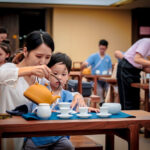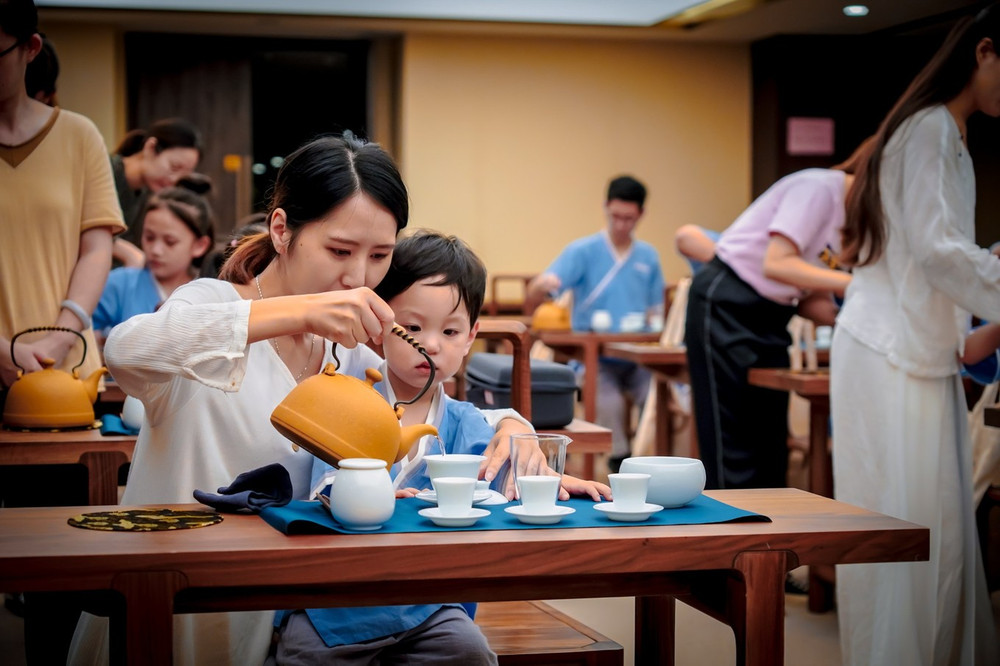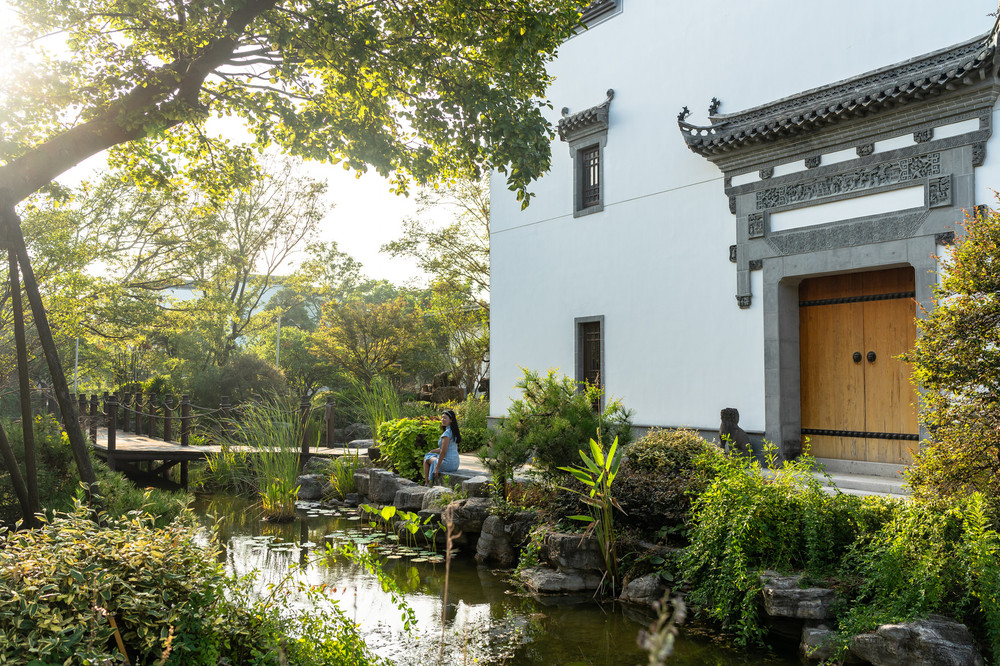Approach: Food writer visited these places – Shanghai Century Avenue, published on December 4, 2019, at 23:56.

Every Christmas, the scent of the holiday is strongest in November when I’m usually wandering abroad. Foreigners’ Spring Festival also involves going to markets, which we call New Year markets, while they call Christmas markets. One mustn’t wander aimlessly, or else one’s mouth will water uncontrollably.
Last week in Copenhagen, about 7500 kilometers away from Shanghai, China, in the old district of socialist revolution, I tasted the Christmas market of the fairy tale kingdom, Denmark. The blind beauty brought by the distance is even more exhilarating than what southern Chinese children feel when they see snow.
At this time, the core commercial streets of Copenhagen are dreamy, with buildings connected by strings of red heart-shaped lights, like the arms of lovers. The entire street has a poetic name, ‘Sweet Street,’ and I swallowed my saliva when I said that. How surreal the place is! I saw the street scenes from the ‘Hans Christian Andersen Fairy Tales’ that my mother read to me as a child, and the miniature version of the Barbie doll mansion that my father bought for me, which was about one meter tall, right before my eyes.
Denmark has many immigrants, possibly due to the good government welfare, even the lunch served in ordinary canteens is organic. I woke up early and ate four different varieties of tomatoes at the hotel’s breakfast buffet, something many Michelin-starred restaurants can’t achieve.
In this season, strolling on the streets is even more fascinating. It’s not the adult revelry of lights and wine but the happiness of a fairy tale kingdom, natural and innocent. I wandered inside, and even bears in the snow and golden stars would smile. However, the temperature in Copenhagen is warmer than in the original Christmas stories, and I don’t know if Santa Claus and reindeer would complain.
To make the Christmas atmosphere more dreamy, Danish buildings even deliberately decorate with fake snow. I think this is something southern China can learn from; if nature doesn’t provide snow, we can create our own. The people here are very friendly, and as I passed each Christmas market stall, the owners would stick their heads out to greet me. They come from different countries. The French boss thinks the milk source here is good for making cheese, and the Italian boss likes the wheat here for making pasta; everyone has their reasons for loving Copenhagen.
The taste of ginger blends into various Christmas foods without borders, from candies, bread, to tea. I can honestly taste this from the myriad of red and green flavors at the Christmas market.
There’s also a bit of gossip: Copenhagen women have a sharp temperament, like iron ladies riding high-heeled thin-wheeled bicycles, leaving men far behind. Therefore, Copenhagen men prefer to marry Thai girls, who are quiet and love reading. The Thai girls, because they are still taking Danish language proficiency tests, haven’t had time to get angry with their incompetent and neglectful husbands.
Pay close attention to the tea here, which is mostly organic, and I can taste a lot of Southeast Asian flavor marks, such as CHAI with spices (the ‘tea’ of Thai people). In fact, Nordic people also love afternoon tea. I’ve discussed this with European friends and tea enthusiasts in China: the European tea culture actually comes from China. The Chinese created black tea. But why isn’t the consumption of black tea in China, but in the West? Because they had the Industrial Revolution, and they needed afternoon tea to refresh and relieve fatigue, then to improve immunity, to prevent everyone from getting plagues when concentrated in cities.
While our nobility still treats tea as a luxury and it’s not widespread, unlike in China, Europeans prefer mixed organic teas that carry the mark of poverty. Westerners have been drinking tea for centuries, mainly in two ways: breakfast tea and afternoon tea. Black tea is not just for digestion after meals, but to warm the stomach and refresh the spirit when people are slightly hungry, especially during breakfast, accompanied by bread and small pastries.
At the Christmas market, I bought many small pastries, mostly with the flavors of ginger, licorice, and chocolate, which are perfect as tea snacks. It is well known that dinner for Westerners is after 8-9 PM, so after the Industrial Revolution, Westerners called lunch brunch, which is more casual and brief, with a long interval until dinner. This environment after the Industrial Revolution gave rise to afternoon tea. Regrettably, no lifestyle is created for fashion and romance; only those squeezed out by living space are enduring. Western afternoon tea is for hunger relief, a tea break for the working class, serving as a source of energy for workers. Although black tea was invented by the Chinese, it is universally applicable in the West due to environmental factors. After solving the problem of drinking, tea must be paired with food to truly solve hunger.Global cultures are interconnected, and we can draw inspiration from Western afternoon tea pairings and Chinese time wisdom. A perfect match can be found in the combination of Chinese date paste cake, cheese, and Pu’er tea, while European cinnamon rolls paired with ginger-flavored organic tea create a heavenly pairing. When it comes to afternoon tea pairings, Chinese tea presents a challenge. As Master Pang, a tea artist, explains, “Chinese people are fortunate to have thousands of experiences to learn from. People from Hangzhou and Jiangnan drink green tea and eat rice noodle-based foods. Anyone who has studied tea knowledge knows that Longjing tea has a chestnut fragrance and the aroma of unpolished rice. Following this idea to make rice noodle-based foods, they will definitely match well with green tea, so the cakes mentioned earlier, such as tangerine red cake and peach shortbread, all match well with green tea.” This kind of pairing also helps control the astringency of the tea and retain its freshness.
Chinese tea, with its delicate and elegant taste and high cost, makes the pairing of tea snacks somewhat complex. Among Europeans, Chinese, and Japanese, the mixed teas Europeans drink are the most suitable for pairing with various desserts. The Japanese, on the other hand, are reluctant to sacrifice the effective parts when making tea, enthusiastic about deep tea processing, and making full use of a tea leaf from beginning to end. Therefore, the overall degree of steaming in Japanese tea is relatively low, whether it is sencha or matcha. The low temperature means that some irritants are not completely removed. In Japan, when you visit their tea ceremony, they first give you a sweet tea cake, then drink tea, because Japanese tea is very stimulating. Therefore, the tea cake needs to be oily and sweet. In Japan, I prefer the European-style afternoon tea set, which is uniquely crafted with a complex and rich aroma, abandoning the burden brought by a single sweetness.
For those who are just starting to drink tea, they often feel uncomfortable in the stomach. Another way to balance ‘strength’ is to add milk. Lapsang souchong with pure milk, the milk foam contains tea polyphenols and caffeine, making the tea smooth, sweet, and silky. This coincides with the European afternoon tea, and in fact, the European habit of adding milk a hundred years ago came from here. Have you noticed that fruit plates are usually not seen in European afternoon tea?
When it comes to enjoying fruits after a meal, no matter how sweet the Chinese late-stage throat tea is, or how sweet the aftertaste is, it cannot compare to the sweetness of fructose. If you are eating grapes or oranges, the fruit acids will bring out the astringency of the tea. You can eat fruit after drinking tea, or eat fruit beforehand, but not simultaneously.
With these musings in mind, I returned from Copenhagen, flying 7500 kilometers, only to discover yet another Christmas market! There, Paddington Bear from the UK is looking up at me. Last weekend, during afternoon tea time, I gathered fans from 8 months to 80 years old to listen to me chatter about the leisurely afternoons in Britain over the past century. At the Paddington Bear exhibition area in Shanghai Century Link Plaza, the aroma of coffee and biscuits filled the air, as we began with British royal gossip, delved into the history of high tea and low tea, and then interpreted and paired the three-tiered trays. In any case, everyone, young and old, left content and well-fed. Thank you to McVitie’s, the 120-year-old royal pastry brand, and Xi Hui Culture; the next sharing session is on December 8th, and I’ll rely on you to gain weight!
British Travel Picnic Sharing Session: December 8th, from 15:00 to 16:00, at the lawn area of Paddington Bear Exhibition in LG2, Shanghai Century Link Plaza. Theme: The UK is an island nation with a small area but a long history and rich cultural landscapes, making it an attractive destination. In London, you can see Big Ben, Tower Bridge, Buckingham Palace, take a boat ride on the Cam River in Cambridge, enjoy the charming natural scenery of the Lake District in the north, and explore the secrets of Stonehenge. Senior food and travel enthusiasts will share stories and experiences of British and European travels, presenting the beauty of British culture together. Collaborating Brands: Little Dayz Boutique, established in 2015 by two women who love natural picnics and had a long-planned spark of inspiration. From an exquisite and elegant themed event to a picnic basket with a pastoral aroma, Little Dayz aims to become a unique and tasteful lifestyle brand in urban life.
Paddington Station is the main entrance of the special exhibition, where Paddington Bear and the Brown family first met, and the station’s name is also the origin of Paddington Bear’s name. The Lost and Found is where Paddington Bear became a member of the Brown family. You can post a WeChat moment with a photo of you and Paddington Bear here, and remember to tag Shanghai Century Link Plaza.Windsor Garden, the home of the Brown family and Paddington Bear, offers a variety of delightful experiences for visitors. Begin by lying on the ground to ‘travel’ to their balcony, take a photo, and share it on Weibo, tagging @Shanghai Century Link Plaza. At Mai Long Train Cafe, indulge in a special Paddington Christmas drink. LEGO enthusiasts can assemble British buildings in the LEGO pool, while helping Paddington Bear fulfill Aunt Lucy’s wish.
Step into the heartwarming lychee phone booth to listen to stories from Lychee hosts and participate in the ‘Love Together’ Paddington Bear language recording event. PETALS PROJECT flower shop offers flowers to bring home warmth and beauty, and during the Paddington Bear special exhibition, they will hold workshops in collaboration with LEGO, allowing for hands-on participation.
Don’t miss the ultra-cool Market fair, featuring the Thanksgiving Post Office of Isole, DeliLif’s good product fair, and the British Boutique Shopping Festival throughout the exhibition period. Write your New Year’s wishes on a sticky note and add it to the ‘Dreams Wall’ wish wall, with Paddington Bear as your companion in remembering and making dreams come true.
The Queen’s Art Christmas Fair will be held from December 24th to 25th, from 10:00 to 22:00, at Shanghai Century Square LG2. Over ten brands will participate in the Christmas fair sales, showcasing British national digestive biscuits, picnic supplies with a rural atmosphere, British royal kitchen utensils, royal umbrellas, royal hair combs, royal socks, and fragrances.
United Biscuits United Kingdom Limited, a subsidiary of the Pladis Group, is the trademark owner of brands like McVitie’s and go ahead fruit leisure extract. Yu Bei Food Trade (Shanghai) Co., Ltd., a wholly-owned subsidiary of United Biscuits in China, is responsible for all business in China. The go ahead fruit leisure extract biscuits, launched in 1996, are now one of the UK’s leading healthy biscuit brands, with 1/5 of UK households purchasing them and 200 million products sold annually, equating to 400 go ahead biscuits sold every minute.
LittleDayz Boutique aims to add light to everyday life with design and art, offering three product lines: Travel Luna for travel design, Woody Mood for natural charm, and Dayz for daily exquisite items.
Ulster Weavers, with 300 years of history, is the designated brand of the British royal kitchen. Known for their high-quality kitchen utensils like teapots, teacups, dishes, and trays, they use bone china with over 45% bone meal content or melamine resin. Their bone china is fine-textured, lightweight, with a warm and soft luster and great texture, and their patterns are made with first-class glaze and advanced glazing technology.
Fulton, the royal umbrella brand, is the first choice for noble travel. Founded in 1955 by inventor and mechanical engineer Arnold Fulton, Fulton has become the most original and representative umbrella brand of British gentleman and royal noble style aesthetics. It occupies 35% of the UK umbrella market and is the largest umbrella supplier in the UK, also being the only umbrella brand designated by the Queen of the UK for business and royal use.FULTON umbrella has created the famous birdcage umbrella for Queen Elizabeth II and her mother, which has been passed down to this day. The FULTON umbrella fully meets people’s needs for outdoor travel and is a symbol of fashion and tasteful life.
Co-branded product: Kent. Kent Brushes was founded by William Kent in 1777 when George III was in power. The history of KENT BRUSHES is the history of British combs. Spanning four centuries, Kent has captured the picky taste of the royal family with its exquisite craftsmanship. In 1780, King George III granted Kent the ‘ROYAL WARRANT’ of the British royal family. And it has provided royal hair combs for nine generations of the British royal family, writing an incomparable glorious record of royal certification. It is the only brand in the UK to continuously obtain the ‘ROYAL WARRANT’ for nine times. In the past 239 years, despite experiencing the frenzy of the industrial revolution and the turmoil of war, the quality of KENT remains unchanged. The biggest feature of Kent is that it uses natural wild boar bristles as comb teeth. Boar bristles have always been considered the best comb tooth material. Its hair comb products were first used by the British royal family and nobles. The Indian wild boar bristles selected by KENT are recognized worldwide as fine and hard natural objects. They have many advantages such as being not easy to break, stimulating the skin, preventing hair loss, massaging the scalp, reducing hair wear, and promoting hair regeneration. Boar bristles can penetrate deep into the scalp layer and bring oil from the hair roots to the ends, playing a role in cleaning and nourishing the hair.
Co-branded product: Corgi, the royal sock brand. Creativity and classic inherited through generations. The story of Corgi began in 1892. In the past 125 years, the hosiery industry in London has undergone refreshing changes from the overall to the details. Corgi is a family business that combines traditional production methods with design trends and focuses on producing high-quality and high-specification cashmere socks, cotton socks, knitted products, etc. Its works are fashionable yet elegant and are famous for being comfortable and healthy. The brand image of ‘quality first’ has become more and more deeply rooted in people’s hearts during a century of development and has become a favorite of fashion people. Corgi’s knitwear epitomizes comfort and luxury, with each pair of socks embodying the artisanal techniques and craftsmanship passed down through generations on ancient manual knitting machines. Perhaps due to the perennially cold climate of Wales, color has infused Corgi with a warm genetic trait. Corgi introduces a variety of warm-colored socks each season, with attractive patterns and designs, especially the brightly colored long socks with distinct color blocks for the heel, toe, and sole areas, which are widely popular in the UK.
Collaborative Brand: Crossing Days. CROSSING DAYS was founded on the banks of the beautiful Thames River in London, UK, symbolizing memories of good life times, combining home art with the concept of comfortable and beautiful living. The design style is not confined to the status quo but endows each product with more emotional expression and comfortable feelings, making it a favorite in the UK’s fashionable home brand circle. [DAYS ARE GOOD, WHEN THEY SMELL GOOD] is the brand philosophy that gives back the good feelings of life into life itself.
During the first anniversary celebration month of Century Link Plaza, many surprises and huge benefits are prepared for everyone: 50% off for big meals, 69 for 100 group purchases, consumption to win Huawei Mate30 mobile phones, and up to 500 yuan in maximum returns. Registered members of Century Link, ‘Century Coffee’, also have exclusive benefits: 8 times points, free parking, and super value lucky bags, etc. The large discount strength and the number of participating merchants are really worth looking forward to.
‘Love Together’ – The British classic healing fairy tale Paddington Bear Shanghai Special Exhibition. Exhibition Time: November 20, 2019 – January 1, 2020. Paddington Bear Shanghai Special Exhibition November 20 – December 1, Yisuo – Thanksgiving Post Office. December 13 – January 1, British Boutique Shopping Festival. December 24 – 25, Shenpo Loves to Eat – Queen’s Art Christmas Market. Exhibition Location: Shanghai Century Link Plaza LG2 Atrium (1192 Century Avenue, Pudong New Area, Shanghai, directly accessible by Rail Transit Lines 2/4/6/9 Century Avenue Station). 7500 kilometers is not far, no matter where, the meaning of the festival is to let people who love each other be together. What Christmas gift do you like









